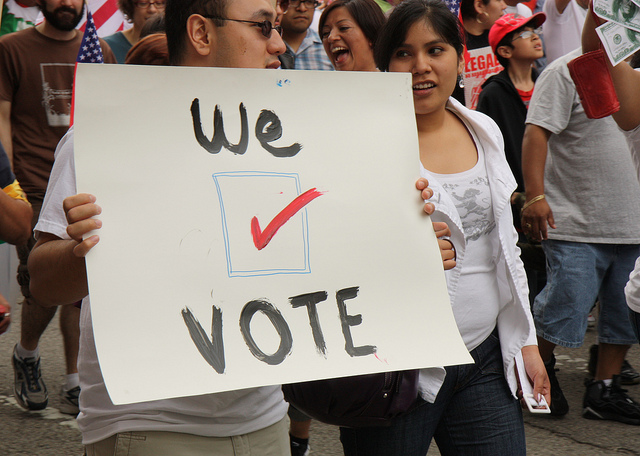1.4 million Latino voters are not asleep

By Victor Landa, NewsTaco
1.4 million more Latinos voted in the 2012 presidential election than in 2008. The number seems to be lost in the latest round of national political speculation.
The U.S. Census Bureau issued a report last month that started all the conjecture: The Diversifying Electorate – Voting Rates by Race and Hispanic Origin. It’s one of those publications that light a bulb in your brain in answer to the question about where your tax dollars go. The sub-header reads “population characteristics,” like counting brown-eyed left handed people. Only in this case it’s Latino voters.
It’s a pithy survey, as you’d expect a Census survey to be. It tells you how Cuban-Ameircans voted as opposed to Puerto Rican and Mexican-American voters. It gives historical perspectives and parses the U.S. Latino population by national origin, age, gender, education and such. It’s just enough data to require a trail of bread crumbs in order to find your way out.
And that’s the problem with almost every survey analysis I’ve read – they lose me in the maze. Most analysts who dive into the Census numbers come back convinced that Latinos have yet to live up to their political potential. And parting from this idea they project the effect on future elections, on political parties, on specific issues and on specific politicians. It all sounds good and makes the analysts sound intelligent. But just because you say something with authority doesn’t mean that what you’re saying is right. (You can chalk that up to our televised and digital cult of personality, but that’s a discussion for another day.)
So, let me repeat the main point in the Census survey: 1.4 million more Latinos voted in the 2012 presidential election than in 2008.
Now, the potential stuff… It’s true that only 48% percent of eligible Latinos voted in 2012 – a drop from 49.9 percent in 2008. So the snapshot conclusion is that Latino voter participation is dropping; that the Latino political giant merely stretched, yawned, turned over and went back to sleep. If you call a 1.4 million increase sleep, pass out the pillows.
What’s been missed by many analysts is a matter of proportion. The growth of the Latino population has been faster than the community’s ability to register it’s eligible voters. Most of the growth of the Latino electorate has been among it’s young people, among it’s newly minted eligible voters – 18 to 24 year olds. These young voters respond more to demographic trends related to their age than to their ethnicity. Young voters overall participate in lower numbers than older voters.
But here’s something interesting. In the 1988 election white voter participation was just under 65 percent; Latino participation was close to 48 percent. Back then, as now, the white population was older than the Latino population. Twenty four years after that the turnout for whites and Latinos was almost identical – 64.1 percent for whites, 48 percent for Latinos. The difference? 3.7 million Latino votes cast in 1988, and 11.2 million in 2012. 4 million eligible Latinos voters who didn’t vote in 1988, and 12.1 million in 2012.
Like I said, it’s a matter of proportion. Young Latinos will vote. Not because they’re Latino but because they’re young, and young non-voters, as they get older, eventually go to the polls.
It’s really not complicated, unless you get lost in the data or you come up with conjectures that make you sound smart. But if they’re saying that a 1.4 million increase is a snooze, hand me a pillow.
[Photo by (Carrie Sloan)]

